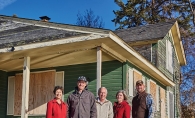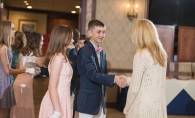If at first you don’t succeed, press the replay button.
This school year, students from a few local high school classrooms are watching recorded lessons posted online before class, then going to school to expand on the material. Students in “flipped classrooms” can rehear the parts of the lecture they didn't understand and jot notes at their own pace in the comfort of their home, the school library or even a coffee shop with Internet access.
By presenting lectures on class website resources like Moodle or Schoology, teachers don't need to worry about the school bell cutting their time short. Sarah Morinville at Mound Westonka High School first tried this teaching model last school year for her advanced placement physics class.
“AP physics has so much content that we must learn by the beginning of May,” she says. “The previous year, I found myself spending lots of time on class lectures and not answering questions and working on problems. When I flipped my class, I found that we could spend all of class time working on problems and lab during class.”
Kim Hoehne, an AP physics and ninth-grade physical sciences teacher at Minnetonka High School, had a similar experience. “My AP physics class loves it,” she says. “Overall the feedback’s been really, really positive. What they really have liked is what we do in class.”
Hoehne notes that her students may find that solving problems is best one day, while other days doing group work and lab-based activities better reinforces what they learned. “I've been trying to really focus on how I can best maximize the time with my kids when I see them in class,” she says.
The flipped format works for Morinville and her students. This school year, she even switched her chemistry courses to follow this model. “Flipping my classes started with the intention of saving time, but it also ended with a deeper understanding of concepts,” she says. One reason may be that students have time during the day to discuss problems together.
But there can be growing pains. According to Morinville, when she explained that homework wouldn't be done at home, her chemistry students were very excited. “Then reality sets in,” she says, adding that many thought that they would receive lecture twice—once at home via video and once at school via in-person lecturing, she says. “I heard many times after the second week of school that a quiz question was not fair because I did not go over it in class. It only took the first quiz to reinforce that they needed to watch the videos.”
“It’s a change,” Hoehne says. Student-teacher conferences and open houses have been opportunities to walk parents through the new format. “It’s a different way than all of us have learned,” she adds. “When I first heard about it, I was very anti-flipping. There’s effective instruction and ineffective instruction. Flipping is not the magic thing to do just to solve all the problems. I wanted to get in on this project so as we started looking at this, we were looking at it from a research-based perspective.”
Seven teachers at Minnetonka High School who are trying a flipped-classroom format were trained last summer to implement the system this school year; they meet every month to make sure the positive feedback keeps coming. Hoehne and two other teachers are teaching ninth-grade physical sciences together; they split who makes the lesson videos among each other. The team effort means students see different teaching styles, which has had an unanticipated benefit.
“We've found it really has created more of a community feeling within that class,” Hoehne says. “[The other teachers’] students see me in the hall and ask me questions or vice versa, and that hasn’t happened any other year.”
Hoehne looks forward to seeing the results for her first AP physics students with a flipped classroom. If Morinville’s numbers are any indication, things look bright: “I had 11 out of 13 students pass the AP test with a three or higher last year,” she says. “The previous year I had [only] a 50 percent passing rate.”









